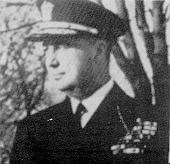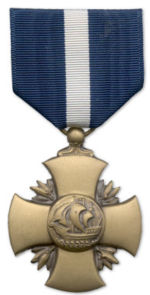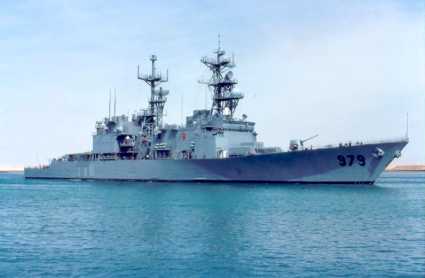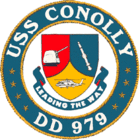Monday Maritime Matters
April 7th, 2008 by xformed
Required reading: Sunday Ship History: Really Big Submarine Ideas by Eagle1 and Fred Fry’s Maritime Monday 105 for all things newsworthy in the maritime realm!
BT
A native of Waukegan, IL, Richard L. Conolly was born April 26th, 1892. He entered the Naval Academy and graduated in 1914.

After graduation in 1914 he was ordered to Mexican waters where he served in USS VIRGINIA. He continued duty in that battleship until May 1915, when he reported aboard USS MONTANA for torpedo instruction. In November 1915 he rejoined VIRGINIA, and in March 1916 he was assigned to USS VERMONT as Torpedo Officer of that battleship for two months. Transferred in May 1916 to USS SMITH, he was aboard that destroyer when the United States entered World War I, in April 1917, and served aboard SMITH while she performed escort duty in European waters out of Brest, France.
He was awarded the Navy Cross for services while attached to SMITH in connection with salvaging the transport WESTBRIDGE, torpedoed by a German submarine in August 1918, as follows: “For distinguished service in the line of his profession on the occasion of the torpedoing of the WESTBRIDGE, when he, with a party of eight others remained on board for five days steering by hand and handling the lines from the tugs, while the ship was towed four hundred miles to port.”
[..]

Assuming command of Destroyer Division 7 in May 1939, he was transferred to duty as Commander Destroyer Squadron 6 on January 30, 1941. He was at sea, in command of Destroyer Squadron 6 at the time of the Japanese attack on Pearl Harbor on December 7, 1941. He subsequently participated in the initial attack on the Gilbert and Marshall Islands on February 1, 1942, as part of the gun bombardment force under command of Fleet Admiral William F. Halsey, Jr.; and in April his destroyers served as escort for the aircraft carrier HORNET from which Lieutenant General Doolittle’s Army planes took off for the first bombing of Tokyo. He also participated in a shore bombardment of Wake Island in command of destroyers in Rear Admiral Raymond A. Spruance’s Task Group.
July 2 1943 Operation Husky
Task Force 86 under the command of Rear Admiral Conolly was scheduled to land the 3rd Infantry Division and two Ranger Battalions of the U.S. Army on the beaches of Licata, Sicily.
Admiral Conolly had a most difficult task: that of moving some 25,000 men from Africa to Sicily in a fleet of landing ships, tank; landing craft, tank; and landing craft, infantry, which was designated JOSS Force. Traveling in a convoy of seven columns, they were slowed at times to a speed of two and a half knots by strong winds and heavy seas. This was the first shore-to-shore amphibious operation to make such extensive use of these landing ships. The Sicilian coastline presented a further complication. Because it was known to be fronted with false beaches which would prevent landing ships from placing their troops and equipment on the shore, pontoon causeways were brought along to bridge the gap. The newly developed amphibious truck, called DUKW, was first employed in this operation and met with great success. False beaches presented no problem for the DUKWs, which could continue in land, as needed, with their cargo.
Jan. 31, 1944 Marshall Islands
Rear Admiral Richard L. Conolly commanded the Northern Task Force, responsible for landing troops under Marine Major General Harry Schmidt. These troops were from the Marine 4th Division. Their objectives were Roi and Namur islands in northern Kwajalein Atoll. On Feb. 1, ships responsible for fire support and bombardment moved in to extremely close range, maximizing their effectiveness, killing a significant number of defenders, and earning Conolly the nickname “Close-in,” along with the gratitude of the troops, who were able to come into the beaches standing up. Navy ships and pilots dropped 6,000 tons of heavy explosives before the Marines set foot on Roi-Namur.
D-Plus 1, Roi
During the afternoon of D-Day, Marines of both regimental combat teams transferred from the transports, outside the lagoon, to the LST’s from which (it had been planned) amphibian tractors would in turn run the assault waves into the lagoon and thence to the beaches. Meanwhile, both Admiral Conolly and General Schmidt had already seen the confusion incident to boating the IVAN Landing Group. They concluded that the only realistic course of action would be to move the LST’s inside the lagoon and launch the morrow’s assault amtracs from positions reasonably near the line of departure. Moreover, considering both the scattered location of many tractors, as well as their dwindling fuel supply, movement of the LST’s would bring sources of support nearer the hard-pressed, dispersed vehicles of the 10th Amphibian Tractor Battalion.
July 1944 Guam
Admiral Conolly, the amphibious group commander for that assault, found it hard to obtain reliable information on the reefs around Guam, he sought out the services of an American geologist who had conducted a prewar survey of the island. And it was Conolly’s detailed questioning of the geologist at Pearl Harbor, prior to his sailing for the operational area, that provided him with the confidence that the assault plan for landing the Fifth Amphibious Corps over the western beaches at Guam was viable.
On July 8 1944 four cruisers of Southern Attack Force led off with a 3-day bombardment, firing five thousand five hundred 5- and 8-inch shells on the coastal defenses. From the 12th through the 16th, four battleships fired more than three thousand 14- and 16-inch shells. During the next 4 days 3 battleships were Joined by 2 others and by 6 cruisers, and they blasted the island with more than 16,000 shells. LCI(G)’s (Landing Craft, Infantry [Gunboat]), closing to within a few yards of the reef, raked trenches and pillboxes and reported the location of enemy positions to the heavier ships. Destroyers screened the larger ships and delivered harassing fires at night. Admiral Conolly, directed the bombardment from the flagship, and supervised the destruction of every known gun emplacement that would seriously endanger the assault landing.
On July 21st 1944 Admiral Conolly’s Task Force 53 lands an Assault Force on Guam under the overall command of Marine Major Gen Roy S. Geiger. After three weeks of hard fighting by Major Gen Allen H. Turnage’s 3rd Marine Division and Brig Gen Lemuel C. Shepard Jr’s 1st Provisional Brigade and Army Major Gen Andrew Bruce’s 77th Infantry Division, Guam’s defenders under LtGen Takeshima Takeshi are overwhelmed and the former American territorial island is retaken.
In 1946 Admiral Conolly was a U.S. Naval Advisor to the Council of Foreign Ministers at the Paris Peace Conference.
In 1950 Rear Adm. Richard L. Conolly was the commander of the U.S. fleet in the Mediterranean and east Atlantic.
On April 8, 1950, a United States Navy patrol plane vanished over the Baltic Sea. The plane, carrying four officers and six enlisted men, was a Privateer, a four-engine plane with a tail assembly somewhat resembling that of the B-29. U.S. officials stated that the plane left Wiesbaden Air Base in Germany and that its destination was Copenhagen, Denmark. Some debris was later sighted by search planes, but there were no survivors. The Soviet Government subsequently stated that Russian planes had fired upon a B-29 Flying Fortress after it had failed to comply with orders and had opened fire upon the Soviet planes.
THE PRESIDENT. “There is an investigation, and it has been ordered by Admiral Conolly, and I can make no comment on it until we know all the facts.â€
1951-1953, Admiral Conolly, became President of the Naval War College. (Conolly Hall is named in honor of Admiral Conolly.)
ADM Conoyly and his wife died in a commercial plane crash March 1st, 1962.


- She was the only one of the 31 “SPRU-Cans” to not have an oval shaped ship’s insignia.
- She was the first SPRUANCE in the Atlantic Fleet to be equipped with TOMAHAWK (in the armored box launchers, as seen above).
- There is a “minor mis-alignment” on the structure of the transom, starboard side, where there is a (maybe no longer) matching chunk of concrete pier missing in Dakar, Senegal.
- She did participate in an “OTL” (operational test launch) of a TOMAHAWK Land Attack missile in August, 1986, accompanied by USS IOWA (BB-61), that also fired a TLAM test weapon. These two ships formed a nominal “BBBG” (Battleship Battle Group), supported by USS DOYLE (FFG-39) with a dual SH-60B LAMPS MK III detachment embarked. This exercise was to formulate tactics for the employment of BBBGs for sea control operations. The Officer in Tactical Command was COMDESRON 32.
- and…then there was the vaccum powered sewage system malfunction…
CONOLLY was the first DD-963 unit to act as a fleet oiler, delivering about 30K gallons of F-76 to USS JESSE L BROWN (FF-1089) in the South Atlantic.
Assigned to COMDESRON 10 in the Atlantic Fleet after commissioning, CONOLLY spent her entire time in commission homeported in Norfolk, VA. Her first “cruise” was to the Mediterrean in 1981, with her second to the Middle East Force (read: Persian Gulf) in 1982. In the summer of 1983, she sailed south to the Panama Canal to make her third cruise as the flagship for UNITAS XXIV/WATC.
The picture shown is post-1984-85 regular overhaul. I will link in the supporting sea stories and reports about USS CONOLLY this evening.
This entry was posted on Monday, April 7th, 2008 at 8:16 am and is filed under Navy. You can follow any responses to this entry through the RSS 2.0 feed. Both comments and pings are currently closed.